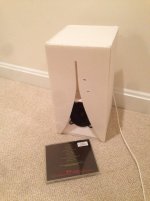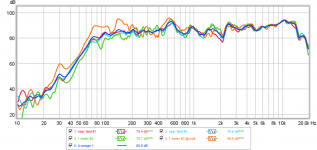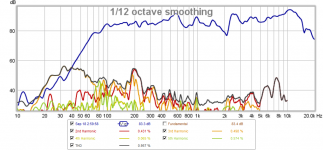For practically costing nothing. These are incredible. Im glad I went with the dual driver, I don't think the single driver would have been enough for my listening levels.
Is that a photo of Karlson?
Thanks Greg!
Yeah, I looked up the cutouts for both drivers and was torn.
I was planning to flush-mount the Seas but if I just went with surface-mount I could just drill two different patterns on two different axes and try them both...
Can anyone comment on diffraction issues with a fullrange and a Karlson enclosure with regards to flush/surface-mount?😕
Is there a smilie for "in over your head?"😀
Flush mounting isn't nearly as important as it is with say dome tweeters. Full range drivers tend to beam the highs somewhat, so that edge diffraction from surface mounted drivers is not nearly as pronounced. Japanese DIY'ers pretty much always surface mount, so Fostex drivers are designed with that in mind.
That said, I flush mounted the Alpair drivers in my mini-karlsonators by adding a layer of cork sheet to the baffle and cutting around the drivers. This is pretty fast and easy.
Of course there will be some diffraction from the 'K-slot' anyway, since it is in effect a diffraction slot...
For the inside of the wings, cork sheet might be a good alternative to felt to experiment with. I expect it would be in between wood and felt in reflectivity.
regarding the picture of John Edward Karlson above, that came from a newspaper article over at Job Ulfman's Karlson site and originally from this picture of Karlson and Jess Oliver titled "Here Comes The Clam" when the Phase III Karlson-Oliver clam/klam was introduced. I believe its the same design as Karlson's APX asymmetric projector. From talking briefly with Jess on the phone, I could tell he really loved and had respect for Mr. Karlson (who passed away in Jan. 1973)
btw, I think may have been the model of klam used for the outdoor feeding of 5000 people (biblical !) with stereo program - my example had a heavy magnet 10" alnico guitar speaker so the frequency range was pretty much limited to the voice region. The big Magna-Clam/AP100 from what I understand ran an Altec 421 woofer and University Sound compression driver on a K-tube. Regular coaxial woofer can be converted to koaxial.
this is not my picture - it was posted on another forum when Jess passed away.

here's a 15 inch Eminence coax with an extended K-tube shoved down the tweeter horn's throat - not particularly elegant and a rough transition which could be smoothed - but it worked pretty well. It also sounded good with the regular coax horn - just a bit more "reverberant" in nature.
here's roughly what my klam15 sounded like indoors with the extended K-tube and a generic crossover.
I will probably either cut off some of the back chamber or load with foam blocks to optimize system Q.
https://www.youtube.com/watch?v=mupb8X6iZ6I
btw, I think may have been the model of klam used for the outdoor feeding of 5000 people (biblical !) with stereo program - my example had a heavy magnet 10" alnico guitar speaker so the frequency range was pretty much limited to the voice region. The big Magna-Clam/AP100 from what I understand ran an Altec 421 woofer and University Sound compression driver on a K-tube. Regular coaxial woofer can be converted to koaxial.
this is not my picture - it was posted on another forum when Jess passed away.

here's a 15 inch Eminence coax with an extended K-tube shoved down the tweeter horn's throat - not particularly elegant and a rough transition which could be smoothed - but it worked pretty well. It also sounded good with the regular coax horn - just a bit more "reverberant" in nature.
An externally hosted image should be here but it was not working when we last tested it.
here's roughly what my klam15 sounded like indoors with the extended K-tube and a generic crossover.
I will probably either cut off some of the back chamber or load with foam blocks to optimize system Q.
https://www.youtube.com/watch?v=mupb8X6iZ6I
Last edited:
Great! Another happy builder 😀
Will you try a combo 4FE35 and TC9FD next?
I thought about the 4FE35 and im going to put in a book mark for now.
Im looking at a speaker build now that can fill room with excellent tonal balance and higher spl, will probably go multi way.
Faital Pro 3FE25 works great in 0.40x
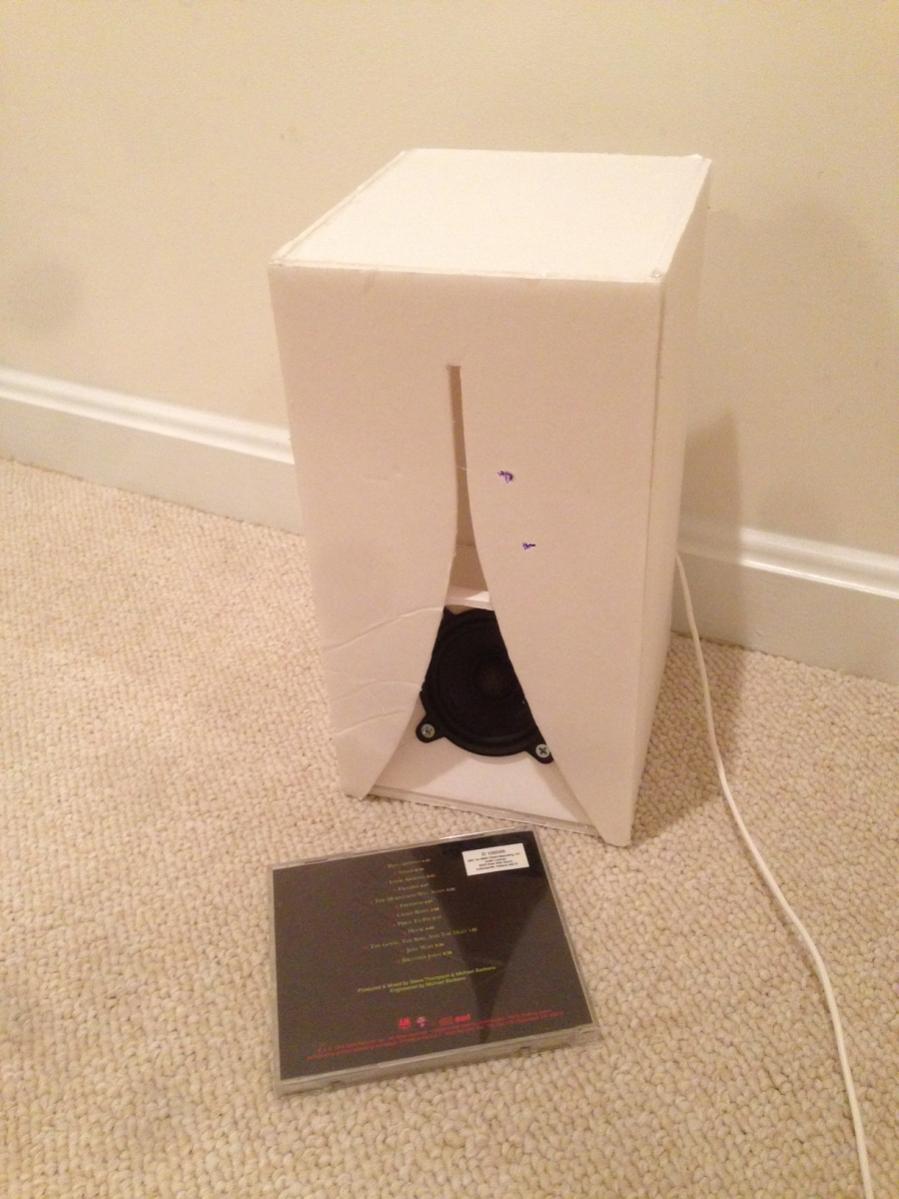
I installed the 3FE25 (ferrite 4-ohm version) into my existing 0.40x Karlsonator. The drivers are almost a perfect match for the cutout left by the Vifa TC9FD. They are actually kind of a tight fit as the magnets are huge - about same dia as cutout.
I took some measurements of the frequency response and distortion - they look very good for how small and simple this speaker is.
Here is the frequency response in nearfield and at 1m sitting on a stool 33in above the floor and 4 ft from a back wall, and also included is the 1m response from same position, and 1m response with speaker sitting on floor against the wall:
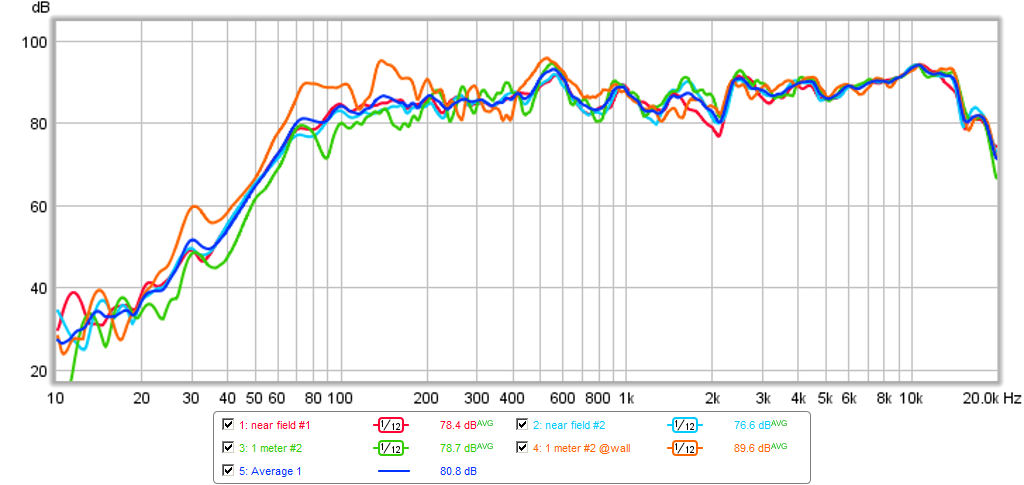
Here is the harmonic distortion, there is a peak at 200Hz caused be foam core cabinet resonance (could use more bracing inside):
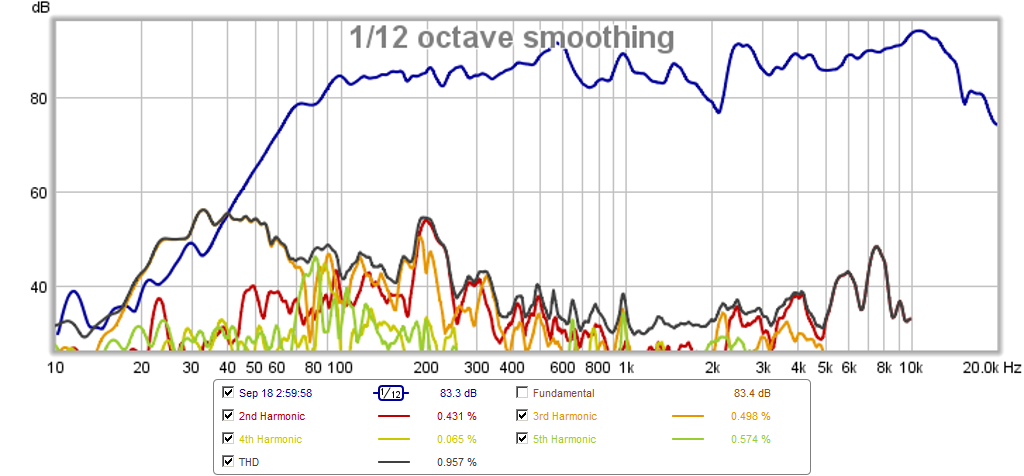
How does it sound? I expected it to sound pretty good based on measurement, and it does. Has a little bit of a HF rise compared to Vifa, so may sound a bit bright - but easy to compensate with a little EQ negative HF shelf. They actually sounded amazing for how small and cheap they are. Here is a sound clip... http://www.diyaudio.com/forums/attachments/full-range/439063d1411026705-mini-karlsonator-0-53x-dual-tc9fds-3fe25-karlsonator-0.40x.zip
So in conclusion, for $19 ($7 more than TC9FD) you get +6dB more sensitivity, and a little more "air" on top. Well worth it and I am thinking that this unit could be a drop in replacement for TC9FD on many projects where you want a little more sensitivity.

I installed the 3FE25 (ferrite 4-ohm version) into my existing 0.40x Karlsonator. The drivers are almost a perfect match for the cutout left by the Vifa TC9FD. They are actually kind of a tight fit as the magnets are huge - about same dia as cutout.
I took some measurements of the frequency response and distortion - they look very good for how small and simple this speaker is.
Here is the frequency response in nearfield and at 1m sitting on a stool 33in above the floor and 4 ft from a back wall, and also included is the 1m response from same position, and 1m response with speaker sitting on floor against the wall:

Here is the harmonic distortion, there is a peak at 200Hz caused be foam core cabinet resonance (could use more bracing inside):

How does it sound? I expected it to sound pretty good based on measurement, and it does. Has a little bit of a HF rise compared to Vifa, so may sound a bit bright - but easy to compensate with a little EQ negative HF shelf. They actually sounded amazing for how small and cheap they are. Here is a sound clip... http://www.diyaudio.com/forums/attachments/full-range/439063d1411026705-mini-karlsonator-0-53x-dual-tc9fds-3fe25-karlsonator-0.40x.zip
So in conclusion, for $19 ($7 more than TC9FD) you get +6dB more sensitivity, and a little more "air" on top. Well worth it and I am thinking that this unit could be a drop in replacement for TC9FD on many projects where you want a little more sensitivity.
Attachments
that's really good - - I've used their 4FE30 in a "K5" size derived from K8 - very clear on acoustic guitar and the Karlsonator mini looks like the better project - - is 3dB of 3FE25's extra sensitivity coming from its lower impedance when used with ~constant voltage amplifiers?
Last edited:
The 3FE25 is still 91dB sensitive as an 8ohm driver - I am using the 4ohm because it has a lower Qts and will let me drive it easily with a 12v supply.
Hi xrk971,
That's a great result w/ the 3FE25 in Post #909.
Have you taken a look if the bottom end can be tweaked in AkAbak, maybe w/ a little more duct length front to back? And, is there a response difference between the 8 and 4 Ohm versions?
Regards,
That's a great result w/ the 3FE25 in Post #909.
Have you taken a look if the bottom end can be tweaked in AkAbak, maybe w/ a little more duct length front to back? And, is there a response difference between the 8 and 4 Ohm versions?
Regards,
I wonder if going to a stiffer material might gain a db or two at the bottom end.
Someday it would be neat to have a printable model for this. It's small enough it could be a laser cut project for Ponoko or one of the other maker sites. I could see it in bamboo or even acrylic. If I didn't already have five million projects to work on, I'd think about doing the templates.
Someday it would be neat to have a printable model for this. It's small enough it could be a laser cut project for Ponoko or one of the other maker sites. I could see it in bamboo or even acrylic. If I didn't already have five million projects to work on, I'd think about doing the templates.
Hi xrk971,
That's a great result w/ the 3FE25 in Post #909.
Have you taken a look if the bottom end can be tweaked in AkAbak, maybe w/ a little more duct length front to back? And, is there a response difference between the 8 and 4 Ohm versions?
Regards,
I don't have an 8ohm 3FE25 on hand to test but would imagine the results to be similar. The front to back length change will affect the volume mostly - rather than length of TL. If volume is made too large, there will be a bass peak overshoot and saddle droop in the response. This can be compensated somewhat by making if narrower to compensate. This is basically the reason why this design is so flexible - those independent adjustments. I have not tried to lengthen just the constriction in this TQWT MLTL - I'm sure it will have an effect. Very similar to the designs being worked by Matthew Morgan and Sabaspeed in the sub woofer forum.
I wonder if going to a stiffer material might gain a db or two at the bottom end.
Someday it would be neat to have a printable model for this. It's small enough it could be a laser cut project for Ponoko or one of the other maker sites. I could see it in bamboo or even acrylic. If I didn't already have five million projects to work on, I'd think about doing the templates.
I think you are right. My experience with the foam core Trynergy gained like 5dB and reduced HD 10dB when I made it stiffer and more damped with latex caulking constrained layers. I may try a CLD foam core 0.4x to test this out. If it did not make sawdust and require power tools I would use Masonite panels. Gasp, the thought of not making something out of foam core. 🙂
Hi xrk971,
Yes, best leave well enough alone, those low end response spikes can become ugly real fast.
Regards,
Yes, best leave well enough alone, those low end response spikes can become ugly real fast.
Regards,
Hi xrk971,
Yes, best leave well enough alone, those low end response spikes can become ugly real fast.
Regards,
You may have a point here, the flex of the foam core may be what gives it such a smooth response. I noticed that GregB's plywood unit with the CHR-70 had a much rougher response compared to my 0.4x in foam core. A double layer on the K-wing probably won't hurt though as I imagine that is probably the source of the 200Hz cabinet resonance peak.
Hi xrk971,
Post #917: "... the flex of the foam core may be what gives it such a smooth response."
Yes, ultimately it's a system. I have wondered about using 1/4-wave tubes (as in Danley, DTS-20), or maybe Helmholtz resonators to tame some of the irregularities, particularly for the original K15. Something like that could be attached to the bottom in form of a little pedestal, but, without an accurate simulation that would be too much trial and error.
Regards,
Post #917: "... the flex of the foam core may be what gives it such a smooth response."
Yes, ultimately it's a system. I have wondered about using 1/4-wave tubes (as in Danley, DTS-20), or maybe Helmholtz resonators to tame some of the irregularities, particularly for the original K15. Something like that could be attached to the bottom in form of a little pedestal, but, without an accurate simulation that would be too much trial and error.
Regards,
Last edited:
Something like that could be attached to the bottom in form of a little pedestal, but, without an accurate simulation that would be too much trial and error.
I have done this is sims and it works like a charm. Particularly, the first peak overshoot in a 4th order or 6th order bandpass you can just add a 1/4 wave cavity near the mouth (folded into main structure) and stuff it with wadding. Make it same width as baffle and about 1 to 1.5 in deep x length required. 12in long for 275Hz peak is a good back of the envelope number to use (scale accordingly for freq you desire to nip in the bud.) I put these into the sims and the bumps magically go away. 🙂
Last edited:
- Home
- Loudspeakers
- Full Range
- Mini Karlsonator (0.53X) with Dual TC9FDs

